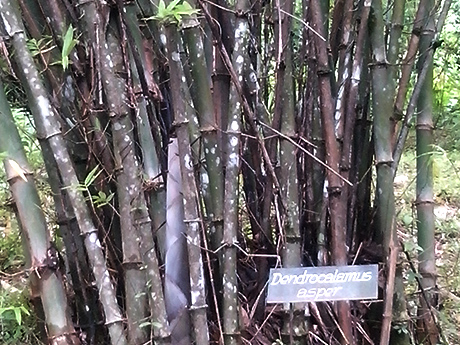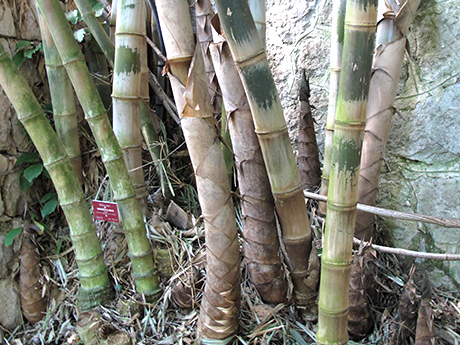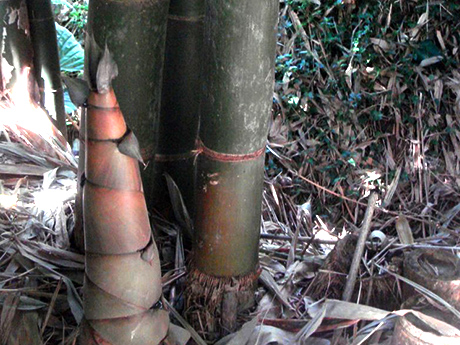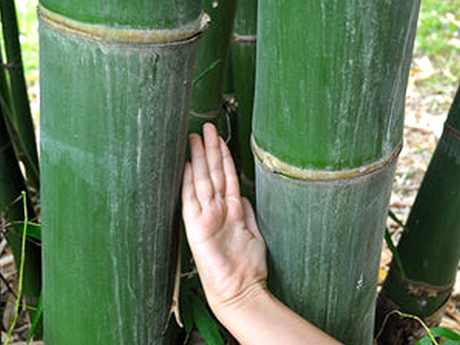Bamboo shoot




Source plants
- scientific name
- Dendrocalamus spp.
- general name
- D. latiflorus:Taiwan giant bamboo (Chinese name: 麻竹)
D. asper: Rough Bamboo, Giant Bamboo (Chinese name: 馬來甜龍竹), (Indonesian name: bambu betung), (Malaysian name: buloh beting), (Thai name: phai-tong)
- overview
-
Dendrocalamus is a tropical Asian genus of giant bamboos in the grass family; its culms grow in clumps like rice plants and multiply by tillering. They do not extend subterranean stems like Phyllostachys pubescens and Phyllostachys bambusoides. In D. latiflorus, the culms grow 8–20 cm in diameter, 20–24 m in height, and 20–70 cm in internode length; the leaves grow 15–40 cm in length. In D. asper, which is generally larger, the culms grow 8–20 cm in diameter, 20–30 m in height, and 20–45 cm in internode length; the leaves grow 15–30 cm in length. In both species, the nodes rise slightly and the culms are thick. They infrequently flower and flowers commonly appear on some, not all, of the culms of each plant. The culms are exported for wide applications, including construction materials, laminated wood, musical instruments, chopsticks, and crafts, among others; bamboo shoots are exported as food. Pickled bamboo shoots, known as menma in Japan, are made by boiling the shoots of D. latiflorus and then drying and lactate-fermenting them.
D. latiflorus, native to Taiwan and Southern China, is widely cultivated in places like Myanmar, Thailand, Vietnam, the Philippines, and Indonesia. The origin of D. asper is unknown (one theory is Northern Malaysia) and is widely cultivated in areas like Thailand, Vietnam, the Philippines, Indonesia, Malaysia, and Sri Lanka. Both species grow best in high rainfall regions but can adapt to various environments. With D. latiflorus, it is said that heavy clay, alkaline sandy soil, and acidic soil are not suited for bamboo shoot production.
Product characteristics
- use
- Bamboo shoots, dried bamboo shoots (pickled bamboo shoots), bamboo charcoal, laminated wood, musical instruments, chopsticks, and crafts
- area
- Widely cultivated in Taiwan, Southern China, and Southeast Asia.
- overview
-
The Royal Forest Department of Thailand is stepping up research and promotion of the cultivation and use of bamboos. According to an interview survey they conducted in October 2015, in Thailand, where approximately 72 species of bamboos occur naturally, D. asper is the most widely planted species and has been cultivated mainly for bamboo shoot production for centuries. However, in 1994 the species simultaneously flowered and died nationwide, bringing the export of bamboo shoots, an important agricultural export for the country, into a crisis. This event dramatically pushed forward the development of bamboo breeding technologies in the country. The important species currently cultivated include the aforementioned D. latiflorus, as well as native species D. strictus and Bambusa bambos (for construction, human consumption, and medicinal uses).
Among the various products currently under development, bamboo charcoal (and bamboo vinegar) is considered promising. Bunton Charcoal, a business that exports the bamboo charcoal powder of D. asper and D. strictus (see the picture below), said they need more technological development before exporting their products to Japan, as the particle size must be 30–40 μm or smaller for the Japanese market. In addition to Bunton Charcoal, Kiengmool and other businesses sell bamboo products for European markets.
Other bamboo products that have been commercialized include textiles/cloth, soil improvement agents, and tea leaves. The tea leaves of D. strictus, in particular, have long been used for medicinal purposes, including as an antipyretic (research has been conducted on the extracts of the tea leaves), and products have been developed for overseas markets, including Japan .
Export and import trends, demands in Japan
According to international trade statistics on bamboos and rattan for 2012, the trade amounts were US$539 million for industrial goods that use bamboos, US$476 million for bamboo fiber products , US$290 million for bamboo and rattan furniture products, and US$276 million for bamboo shoots, with bamboo shoots trade growing from US$223 million in 2007. Looking at the export figures by country, China has a near monopoly with US$240 million (2012), followed by the EU at US$20.6 million and Thailand at US$12 million. On the other hand, when it comes to imports, Japan leads at US$160.4 million (2012) (59%), and the remaining imports are accounted for by two other regions, i.e., the EU at US$55.2 million and the U.S. at US$40.4 million.
In the last 10 years, Japan’s annual import of bamboo shoots has been around 180–200 thousand tons and 83–90% of the total domestic consumption has been met by imports (a majority of which comes from China). A majority of water-boiled bamboo shoots in tins and pouches currently circulated in Japan are imports from China. While the bamboo shoot species typically eaten in Japan is Phyllostachys edulis, which was originally brought from China, D. latiflorus and D. asper in Thailand, the third largest exporter of bamboo shoots in the world following China, are exported as boiled bamboo shoots in tins and pouches for European and North American markets.
Pickled bamboo shoots are traditional cooking ingredients originating from Jiayi in Taiwan, and are called kang-sungM in the local language. The production area has moved to Southern China (e.g., Guangdong, Guangxi, and Fujian) due to a sharp decline in farmers in Taiwan, amid the country’s rapid economic growth. As pickled bamboo shoots are made from D. latiflorus, the species cultivated widely in Southeast Asia, the bamboo shoots can be sourced from many countries, not just Taiwan and China. Recently, Kawasaki Foods (Nozaki) has started selling “Hosaki Menma (pickled bamboo shoots made with the tips of bamboo shoots)” in Japan, which uses bamboo shoots produced in Thailand. Bamboo shoot production is considered a promising industry in not only Thailand, but also Vietnam, the Philippines, and Myanmar.
- references
-
- http://www.guaduabamboo.com/species/dendrocalamus-latiflorus
- http://www.guaduabamboo.com/species/dendrocalamus-asper
- https://en.wikipedia.org/wiki/Bamboo_shoot
- International Network for Bamboo and Rattan (INBAR) (2014) International Trade of Bamboo and Rattan 2012. 58pp. (http://www.inbar.int)
- Carmelita, M. & N. Rivera (2006) Economics and market potential of bamboo for shoots and engineered products in the Philippines. Silvicultural management of bamboo in the Philippines and Australia for shoots and timber (Ed. D. J. Midmore), p94-107, Proceedings of a workshop held in Los Baños, the Philippines, 22–23 November 2006
- 林野庁・特用林産物の生産動向(更新日:平成27年9月29)http://www.rinya.maff.go.jp/j/tokuyou/tokusan/3.html
- 株式会社 大門 http://www.menmaya.com/menma/index.html
- 株式会社 川崎フーズ http://www.cornedbeef.jp/seihin.html


